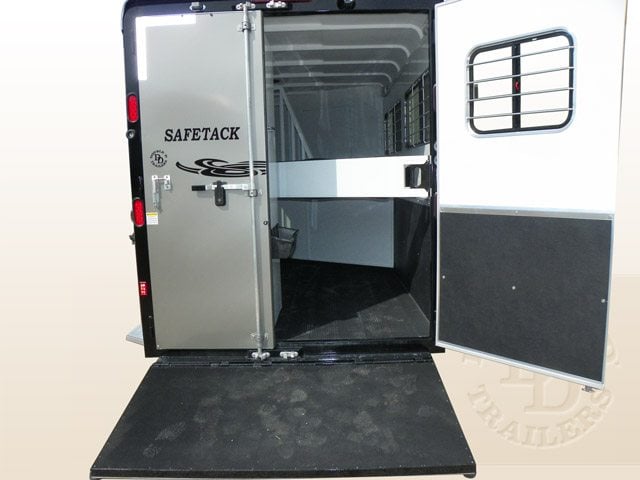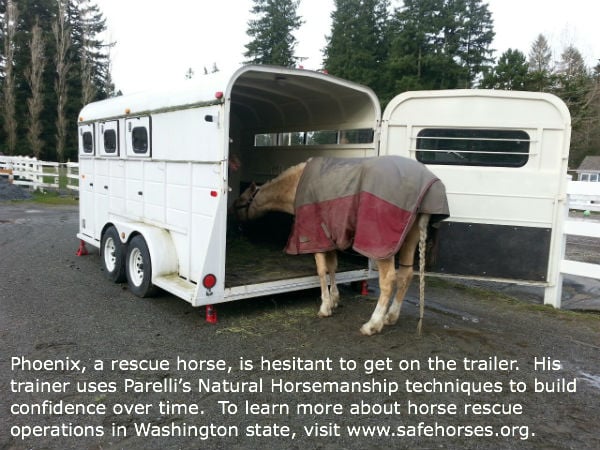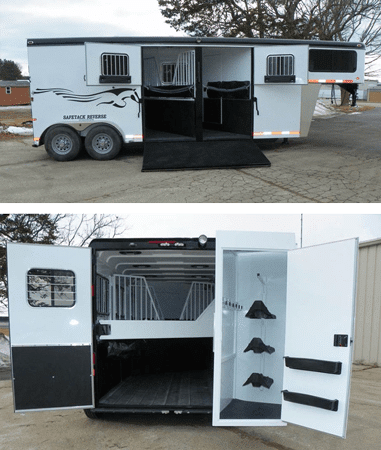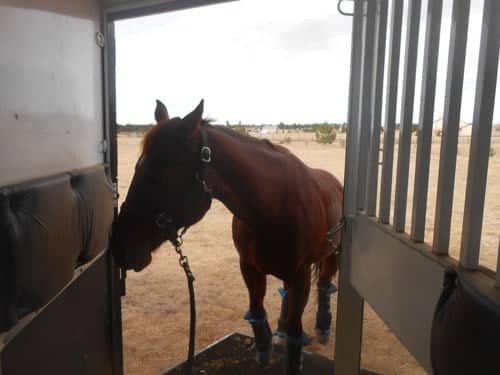Ramps vs Step-Ups: Safer Loading with Your New Custom Trailer

To ramp or not to ramp… that is the question!
Sure, ramps are handy, but some horse trailer ramps end up being more of a hazard than a help. Then, there’s the issue of skinned legs and reluctant backers with step-up trailers. Is one really better than the other?
For many horse owners, they’ve become so used to a certain type of trailer, they would never consider switching. But there are some pros and cons on both sides of the matter… having a ramp or having a step-up. And – just to keep things interesting – here at Double D Trailers, we build our ramps just a little bit differently than other brands.
So, without further ado… let’s examine both options!
Reasons to Choose a Step-Up Horse Trailer
Some Ramps are Poorly Designed. If you are looking at other trailer brands, make sure you don’t end up with one of the many poorly designed ramps:
Ramps Can Be Steep and Slippery. Bare aluminum or steel ramps can be incredibly slippery -- even more so if your horse has been walking through wet grass.
 Sliding isn’t a trust-building activity for a horse. So without adding a mat or having a protective coating installed on the ramp, these poorly design ramps do more harm than good. We’ve solved this problem by mounting our ramps at a lower pivot point so they are less steep and slippery.
Sliding isn’t a trust-building activity for a horse. So without adding a mat or having a protective coating installed on the ramp, these poorly design ramps do more harm than good. We’ve solved this problem by mounting our ramps at a lower pivot point so they are less steep and slippery.
Ramps Can Be Heavy. There are many trailers out there with very heavy ramps that are hard to lift into place. This can become a safety hazard if you are trying to get to a distressed horse quickly. Not to mention the pain you might feel in your back! As you’ll see below, we’ve spring-loaded our ramps making them MUCH easier to lift.
Horse Preference. Ok. When it comes to loading an anxious horse onto the trailer, whatever the horse wants, he gets. So if your horse prefers step-up horse trailers, you may want to listen to him.
Cost. Let’s not be shy. Cost is a very important factor for many buyers. When helping new buyers design their custom horse trailers, we try our best to suggest add-ons that will provide value and safety for the horses. A ramp will cost you some extra money, but it may be worth it in the end.
Reasons to Choose a Ramp Horse Trailer from Double D Trailers

If you look at our recent sales history, 41 of our last 50 trailer buyers have purchased trailers with ramps. So, you can see, our designs are pretty popular!
Less Angle. At Double D Trailers, we mount ramps at a lower pivot point than most builders which creates less of an incline and reduces the risk of slipping. Not to mention the traction surface works well for grip even on wet rainy days.
Easy-to-Lift. Next, our ramps are spring-loaded so they are much easier to lift than the average horse trailer ramp. In fact, you could lift it with just one hand!
Less Risk of Leg Injury. Ramps can be much safer for your horse’s legs. One of the most common problems with step-up trailers is skinned knees and other leg injuries. If a horse is blindly backing off a step-up trailer, they sometimes misjudge the edge and scrape their leg. Other times, they step down so their leg is slightly underneath the trailer, risking injury when it straightens.
Learn How to Avoid Tendon Damage in Horses From Leg Wraps
Rear End Collision Protection for Your Horse. When designing trailers, we always recommend customers choose full-height rear doors on their trailer with an additional ramp mounted on the outside. This provides an extra layer of structural protection for your horse in the case of a rear end collision.
But the protection doesn’t stop there. If you have a SafeTack horse trailer the SafeTack saddle compartment works as an additional crumple zone to protect your horse. And lastly, the rear divider provides one more barrier for your animals.
When you put this all together – full-height doors, ramp, SafeTack compartment, and divider – it makes for one of the safest designs out there against rear-end collisions.
Flexibility for Loading and Unloading Location. Ramps allow for a bit more flexibility in loading and unloading zones. Unlike with a step-up, a ramp can handle some variation in the terrain without forcing the rear of the trailer up so high your horse can’t load or unload.
Just make sure your trailer isn’t jacked up too high in the front. Since our ramps have such a low pivot point, some people jack up the front of the trailer so high, they aren’t able to open their rear doors without scrubbing the top of the ramp.
How to Easily Load and Unload an Anxious Horse onto a Horse Trailer

More Secure Horse Backing. Ramps will give your horse more confidence when backing off a trailer. Because, let’s face it, backing a horse out of a step-up trailer is downright scary. A smaller two horse trailer won’t always have the space to turn a horse around for unloading, forcing him instead to blindly step down.
Ramps provide an easier way for the animal to gradually reach the ground. It’s much less stressful than a sudden drop for a horse who can’t see what’s behind him. The sudden drop can lead to accidents and injuries in horses just learning to trailer or those otherwise distracted.
Erase Unloading Stress Completely. One of the best things about our SafeTack trailer is its ability to erase unloading stress entirely. We do this by providing enough space for many horses to fully turn around inside they trailer before they walk off. It’s much less stressful than trying to back.
If you want to take things one step farther, you may want to choose a side loading ramp and door. With this configuration, the horses would load from the side into a rear-facing stall. Then, they can offload by walking forwards off the rear end of the trailer.
This Reverse Load SafeTack design is available on all of our slant load trailers – from a one horse trailer all the way up to a six horse trailer.
Because we build our custom horse trailers from the ground up, we’re happy to let you decide what’s best for your horse -- from the stall placement to the ramp. Both ramps and step-ups are great options for the right horses and owners. If you’re still having trouble deciding, contact Brad and he’ll walk you through your choices.
We would love to hear your comments, questions and experiences regarding ramps, feel free to post below!

